Exploring the Mobilities Turn: Nomadism, Sedentarism, and Tech Impact
VerifiedAdded on 2020/04/01
|8
|1885
|77
Essay
AI Summary
This essay examines the 'Mobilities Turn' in migration studies, exploring the concepts of nomadism, sedentarism, and their interplay with networked technologies. It discusses how technological advancements have reshaped social interactions, work, and identity, leading to the rise of digital nomadism. The essay analyzes the impact of technology on both nomadism and sedentarism, highlighting the complexities of mobility in the modern world. It also addresses the potential for future mobilities research, emphasizing the importance of understanding the actions of both human and non-human actors. The essay concludes by emphasizing the central role of mobility in human development and the need to understand the evolving dynamics of globalization, nomadism, and sedentarism in a technologically advanced world.

“Mobilities Turn”
By (name)
Course
Professor
Institution
Date
By (name)
Course
Professor
Institution
Date
Paraphrase This Document
Need a fresh take? Get an instant paraphrase of this document with our AI Paraphraser
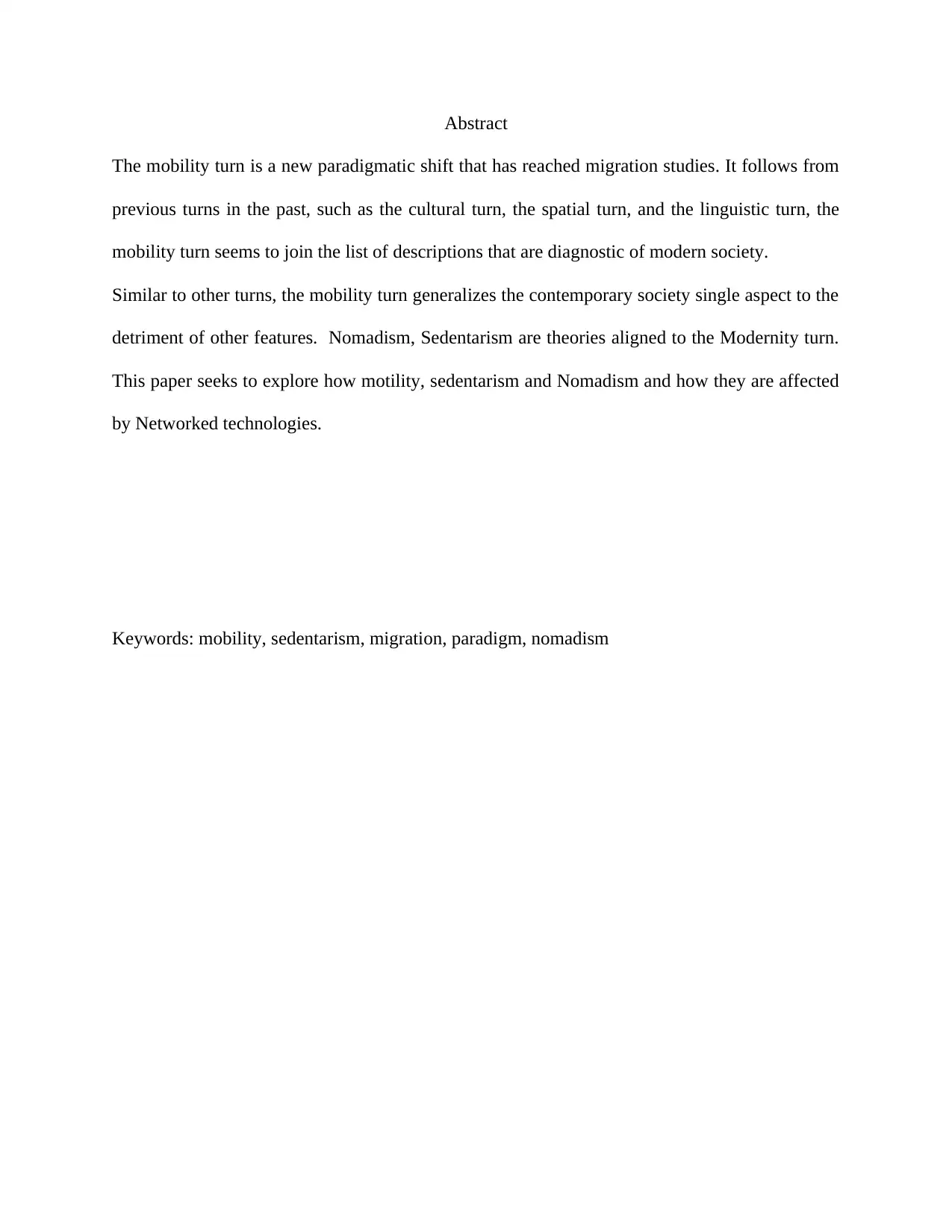
Abstract
The mobility turn is a new paradigmatic shift that has reached migration studies. It follows from
previous turns in the past, such as the cultural turn, the spatial turn, and the linguistic turn, the
mobility turn seems to join the list of descriptions that are diagnostic of modern society.
Similar to other turns, the mobility turn generalizes the contemporary society single aspect to the
detriment of other features. Nomadism, Sedentarism are theories aligned to the Modernity turn.
This paper seeks to explore how motility, sedentarism and Nomadism and how they are affected
by Networked technologies.
Keywords: mobility, sedentarism, migration, paradigm, nomadism
The mobility turn is a new paradigmatic shift that has reached migration studies. It follows from
previous turns in the past, such as the cultural turn, the spatial turn, and the linguistic turn, the
mobility turn seems to join the list of descriptions that are diagnostic of modern society.
Similar to other turns, the mobility turn generalizes the contemporary society single aspect to the
detriment of other features. Nomadism, Sedentarism are theories aligned to the Modernity turn.
This paper seeks to explore how motility, sedentarism and Nomadism and how they are affected
by Networked technologies.
Keywords: mobility, sedentarism, migration, paradigm, nomadism
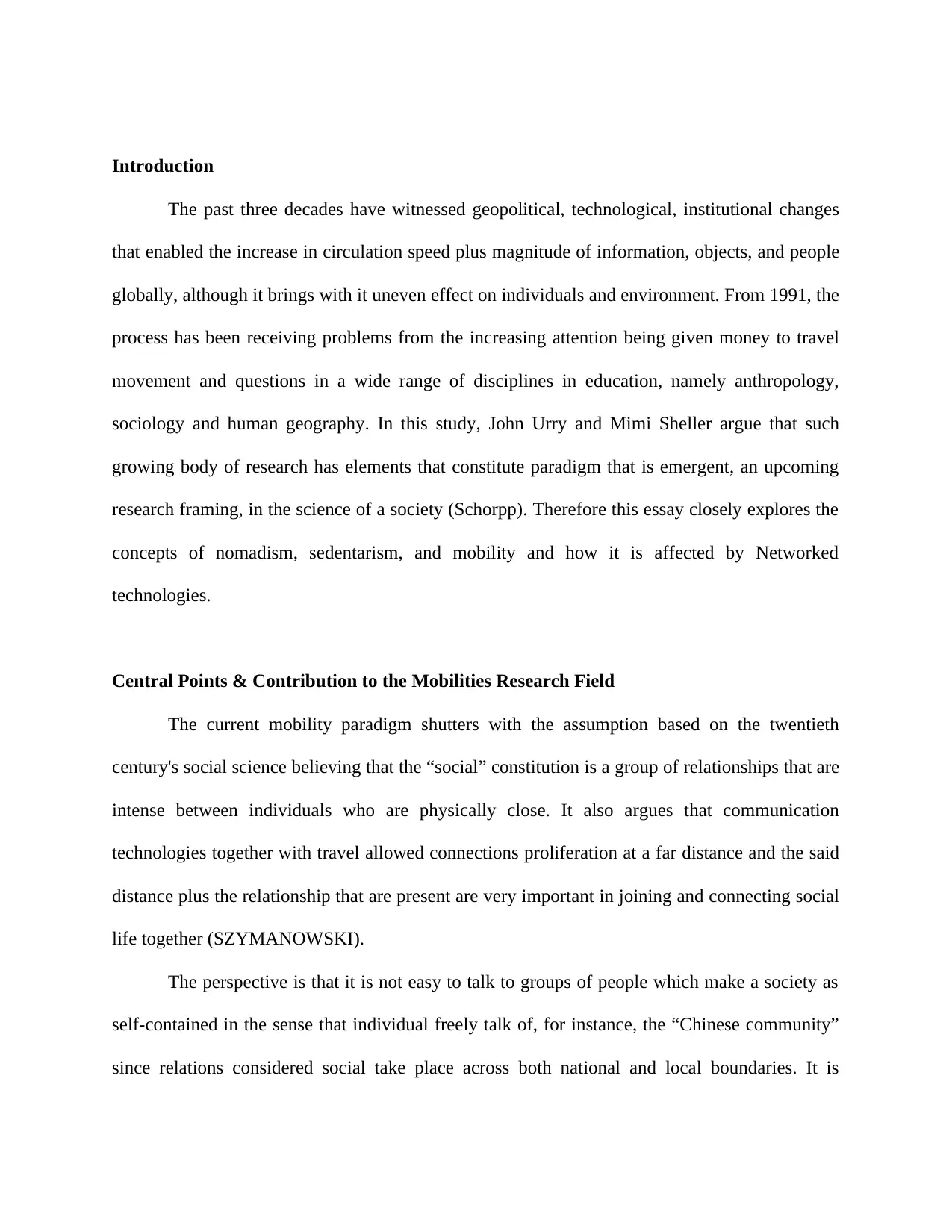
Introduction
The past three decades have witnessed geopolitical, technological, institutional changes
that enabled the increase in circulation speed plus magnitude of information, objects, and people
globally, although it brings with it uneven effect on individuals and environment. From 1991, the
process has been receiving problems from the increasing attention being given money to travel
movement and questions in a wide range of disciplines in education, namely anthropology,
sociology and human geography. In this study, John Urry and Mimi Sheller argue that such
growing body of research has elements that constitute paradigm that is emergent, an upcoming
research framing, in the science of a society (Schorpp). Therefore this essay closely explores the
concepts of nomadism, sedentarism, and mobility and how it is affected by Networked
technologies.
Central Points & Contribution to the Mobilities Research Field
The current mobility paradigm shutters with the assumption based on the twentieth
century's social science believing that the “social” constitution is a group of relationships that are
intense between individuals who are physically close. It also argues that communication
technologies together with travel allowed connections proliferation at a far distance and the said
distance plus the relationship that are present are very important in joining and connecting social
life together (SZYMANOWSKI).
The perspective is that it is not easy to talk to groups of people which make a society as
self-contained in the sense that individual freely talk of, for instance, the “Chinese community”
since relations considered social take place across both national and local boundaries. It is
The past three decades have witnessed geopolitical, technological, institutional changes
that enabled the increase in circulation speed plus magnitude of information, objects, and people
globally, although it brings with it uneven effect on individuals and environment. From 1991, the
process has been receiving problems from the increasing attention being given money to travel
movement and questions in a wide range of disciplines in education, namely anthropology,
sociology and human geography. In this study, John Urry and Mimi Sheller argue that such
growing body of research has elements that constitute paradigm that is emergent, an upcoming
research framing, in the science of a society (Schorpp). Therefore this essay closely explores the
concepts of nomadism, sedentarism, and mobility and how it is affected by Networked
technologies.
Central Points & Contribution to the Mobilities Research Field
The current mobility paradigm shutters with the assumption based on the twentieth
century's social science believing that the “social” constitution is a group of relationships that are
intense between individuals who are physically close. It also argues that communication
technologies together with travel allowed connections proliferation at a far distance and the said
distance plus the relationship that are present are very important in joining and connecting social
life together (SZYMANOWSKI).
The perspective is that it is not easy to talk to groups of people which make a society as
self-contained in the sense that individual freely talk of, for instance, the “Chinese community”
since relations considered social take place across both national and local boundaries. It is
⊘ This is a preview!⊘
Do you want full access?
Subscribe today to unlock all pages.

Trusted by 1+ million students worldwide
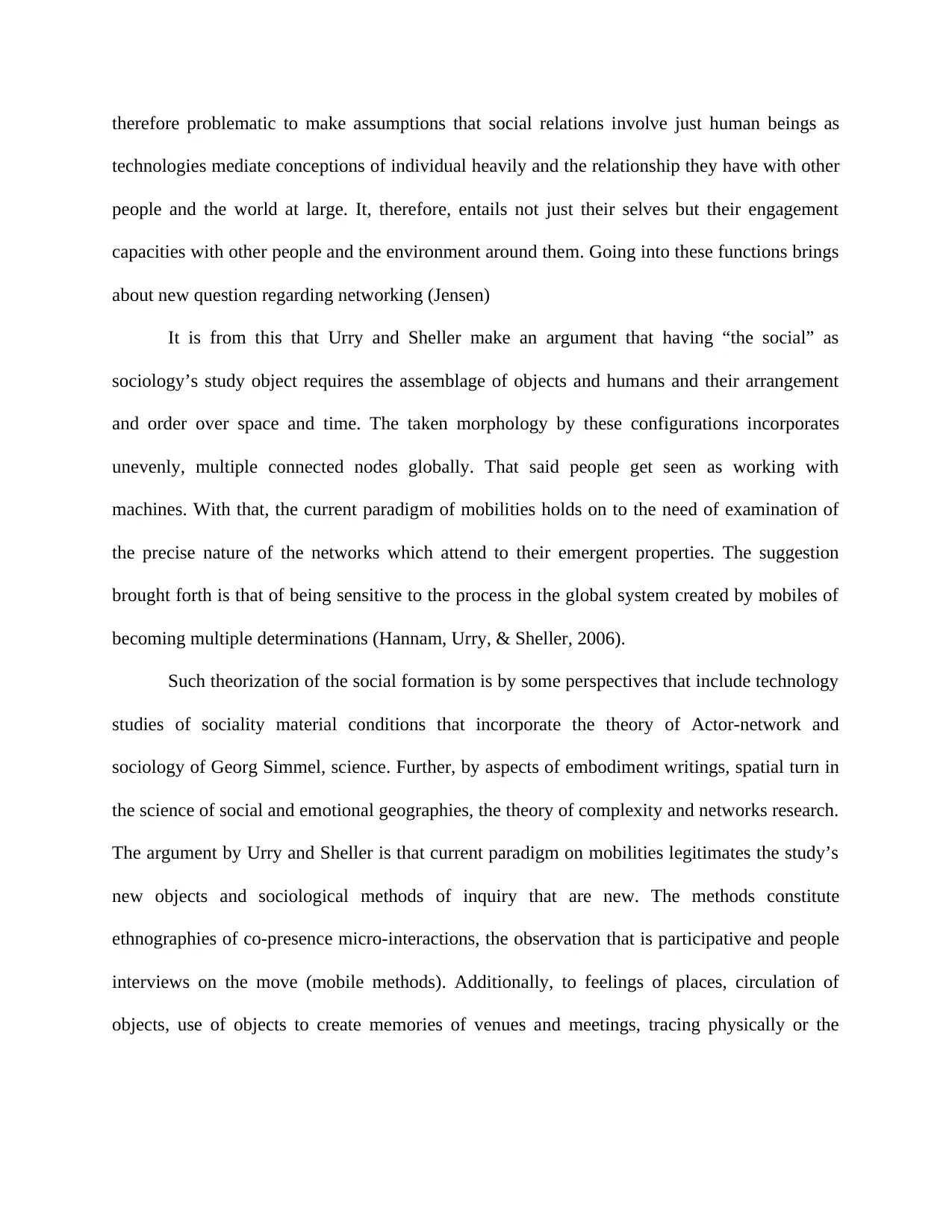
therefore problematic to make assumptions that social relations involve just human beings as
technologies mediate conceptions of individual heavily and the relationship they have with other
people and the world at large. It, therefore, entails not just their selves but their engagement
capacities with other people and the environment around them. Going into these functions brings
about new question regarding networking (Jensen)
It is from this that Urry and Sheller make an argument that having “the social” as
sociology’s study object requires the assemblage of objects and humans and their arrangement
and order over space and time. The taken morphology by these configurations incorporates
unevenly, multiple connected nodes globally. That said people get seen as working with
machines. With that, the current paradigm of mobilities holds on to the need of examination of
the precise nature of the networks which attend to their emergent properties. The suggestion
brought forth is that of being sensitive to the process in the global system created by mobiles of
becoming multiple determinations (Hannam, Urry, & Sheller, 2006).
Such theorization of the social formation is by some perspectives that include technology
studies of sociality material conditions that incorporate the theory of Actor-network and
sociology of Georg Simmel, science. Further, by aspects of embodiment writings, spatial turn in
the science of social and emotional geographies, the theory of complexity and networks research.
The argument by Urry and Sheller is that current paradigm on mobilities legitimates the study’s
new objects and sociological methods of inquiry that are new. The methods constitute
ethnographies of co-presence micro-interactions, the observation that is participative and people
interviews on the move (mobile methods). Additionally, to feelings of places, circulation of
objects, use of objects to create memories of venues and meetings, tracing physically or the
technologies mediate conceptions of individual heavily and the relationship they have with other
people and the world at large. It, therefore, entails not just their selves but their engagement
capacities with other people and the environment around them. Going into these functions brings
about new question regarding networking (Jensen)
It is from this that Urry and Sheller make an argument that having “the social” as
sociology’s study object requires the assemblage of objects and humans and their arrangement
and order over space and time. The taken morphology by these configurations incorporates
unevenly, multiple connected nodes globally. That said people get seen as working with
machines. With that, the current paradigm of mobilities holds on to the need of examination of
the precise nature of the networks which attend to their emergent properties. The suggestion
brought forth is that of being sensitive to the process in the global system created by mobiles of
becoming multiple determinations (Hannam, Urry, & Sheller, 2006).
Such theorization of the social formation is by some perspectives that include technology
studies of sociality material conditions that incorporate the theory of Actor-network and
sociology of Georg Simmel, science. Further, by aspects of embodiment writings, spatial turn in
the science of social and emotional geographies, the theory of complexity and networks research.
The argument by Urry and Sheller is that current paradigm on mobilities legitimates the study’s
new objects and sociological methods of inquiry that are new. The methods constitute
ethnographies of co-presence micro-interactions, the observation that is participative and people
interviews on the move (mobile methods). Additionally, to feelings of places, circulation of
objects, use of objects to create memories of venues and meetings, tracing physically or the
Paraphrase This Document
Need a fresh take? Get an instant paraphrase of this document with our AI Paraphraser
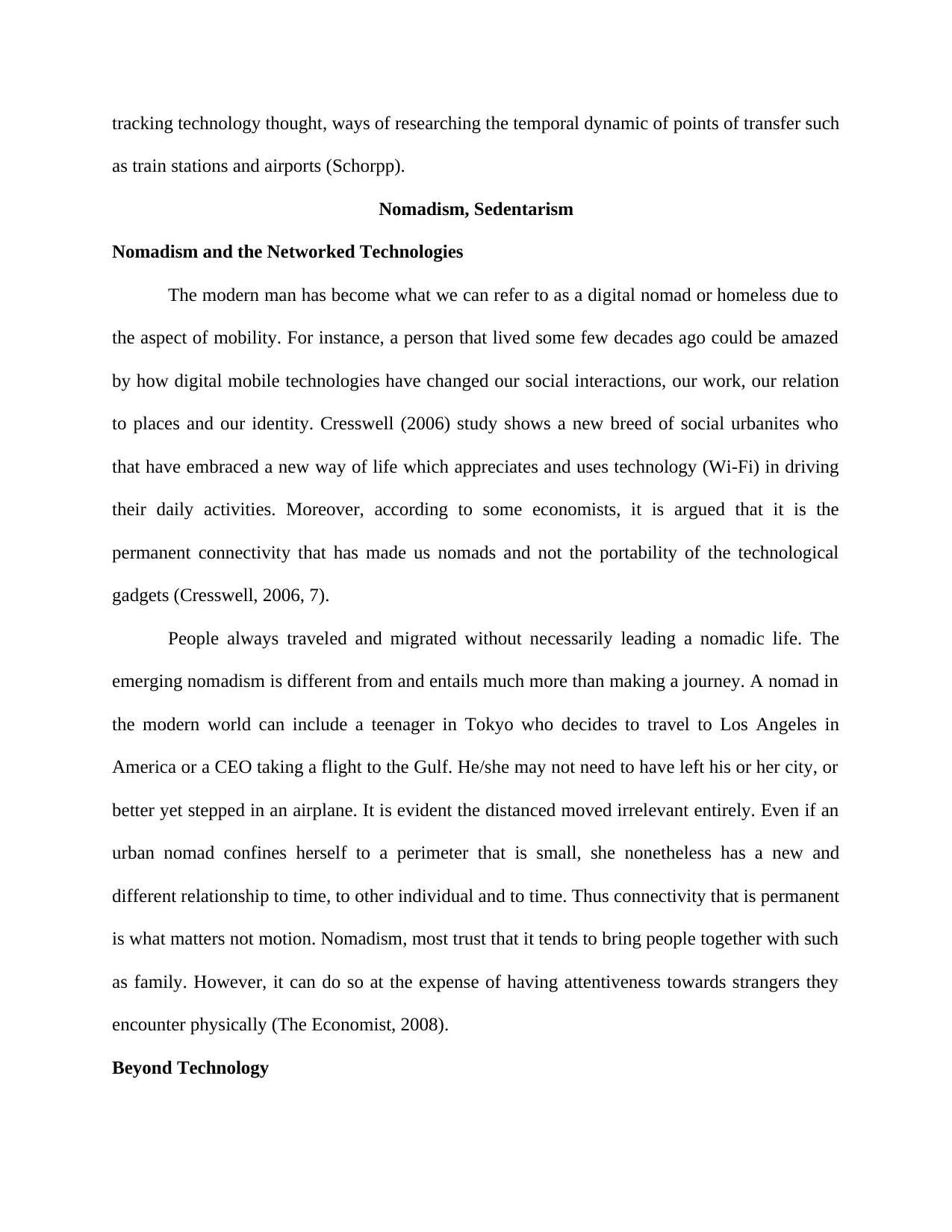
tracking technology thought, ways of researching the temporal dynamic of points of transfer such
as train stations and airports (Schorpp).
Nomadism, Sedentarism
Nomadism and the Networked Technologies
The modern man has become what we can refer to as a digital nomad or homeless due to
the aspect of mobility. For instance, a person that lived some few decades ago could be amazed
by how digital mobile technologies have changed our social interactions, our work, our relation
to places and our identity. Cresswell (2006) study shows a new breed of social urbanites who
that have embraced a new way of life which appreciates and uses technology (Wi-Fi) in driving
their daily activities. Moreover, according to some economists, it is argued that it is the
permanent connectivity that has made us nomads and not the portability of the technological
gadgets (Cresswell, 2006, 7).
People always traveled and migrated without necessarily leading a nomadic life. The
emerging nomadism is different from and entails much more than making a journey. A nomad in
the modern world can include a teenager in Tokyo who decides to travel to Los Angeles in
America or a CEO taking a flight to the Gulf. He/she may not need to have left his or her city, or
better yet stepped in an airplane. It is evident the distanced moved irrelevant entirely. Even if an
urban nomad confines herself to a perimeter that is small, she nonetheless has a new and
different relationship to time, to other individual and to time. Thus connectivity that is permanent
is what matters not motion. Nomadism, most trust that it tends to bring people together with such
as family. However, it can do so at the expense of having attentiveness towards strangers they
encounter physically (The Economist, 2008).
Beyond Technology
as train stations and airports (Schorpp).
Nomadism, Sedentarism
Nomadism and the Networked Technologies
The modern man has become what we can refer to as a digital nomad or homeless due to
the aspect of mobility. For instance, a person that lived some few decades ago could be amazed
by how digital mobile technologies have changed our social interactions, our work, our relation
to places and our identity. Cresswell (2006) study shows a new breed of social urbanites who
that have embraced a new way of life which appreciates and uses technology (Wi-Fi) in driving
their daily activities. Moreover, according to some economists, it is argued that it is the
permanent connectivity that has made us nomads and not the portability of the technological
gadgets (Cresswell, 2006, 7).
People always traveled and migrated without necessarily leading a nomadic life. The
emerging nomadism is different from and entails much more than making a journey. A nomad in
the modern world can include a teenager in Tokyo who decides to travel to Los Angeles in
America or a CEO taking a flight to the Gulf. He/she may not need to have left his or her city, or
better yet stepped in an airplane. It is evident the distanced moved irrelevant entirely. Even if an
urban nomad confines herself to a perimeter that is small, she nonetheless has a new and
different relationship to time, to other individual and to time. Thus connectivity that is permanent
is what matters not motion. Nomadism, most trust that it tends to bring people together with such
as family. However, it can do so at the expense of having attentiveness towards strangers they
encounter physically (The Economist, 2008).
Beyond Technology
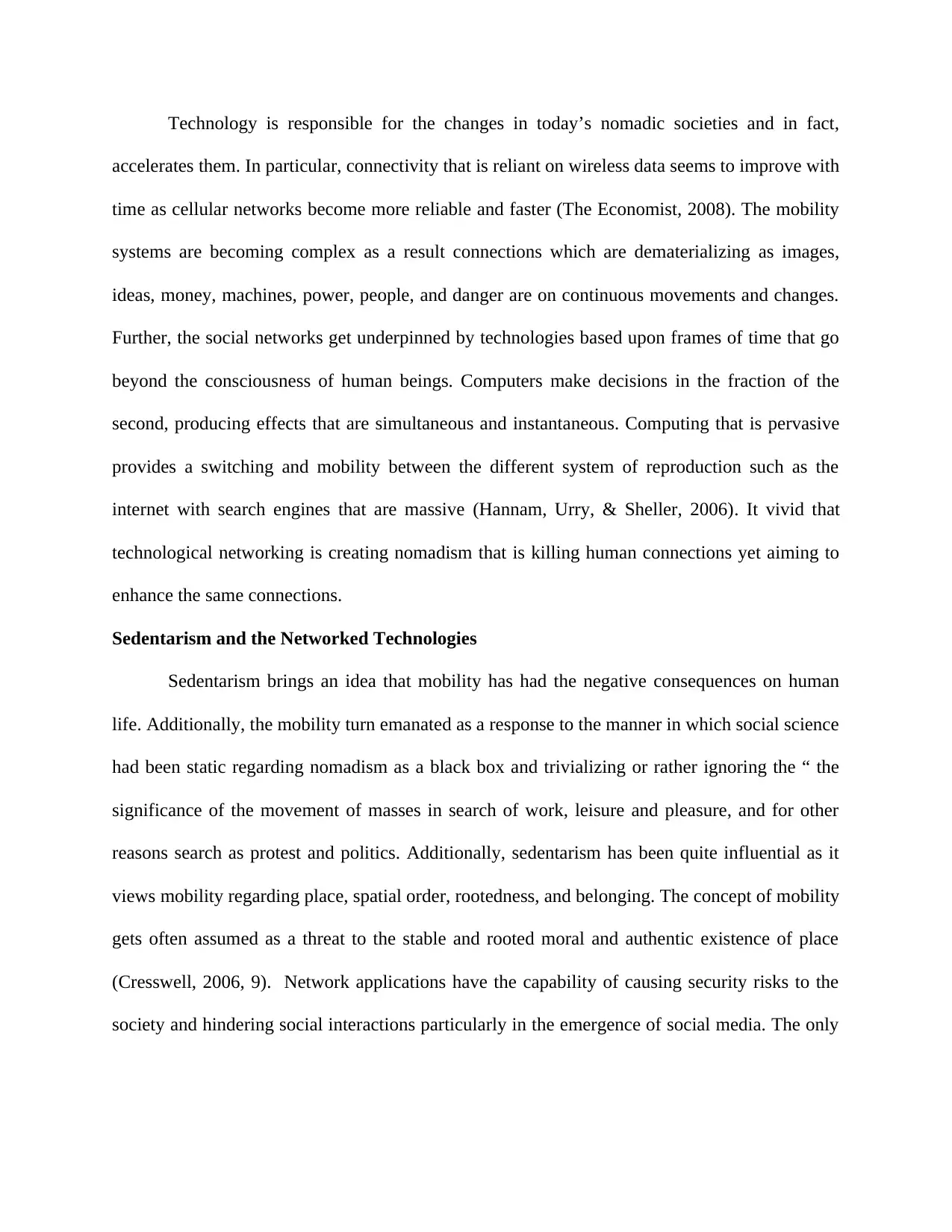
Technology is responsible for the changes in today’s nomadic societies and in fact,
accelerates them. In particular, connectivity that is reliant on wireless data seems to improve with
time as cellular networks become more reliable and faster (The Economist, 2008). The mobility
systems are becoming complex as a result connections which are dematerializing as images,
ideas, money, machines, power, people, and danger are on continuous movements and changes.
Further, the social networks get underpinned by technologies based upon frames of time that go
beyond the consciousness of human beings. Computers make decisions in the fraction of the
second, producing effects that are simultaneous and instantaneous. Computing that is pervasive
provides a switching and mobility between the different system of reproduction such as the
internet with search engines that are massive (Hannam, Urry, & Sheller, 2006). It vivid that
technological networking is creating nomadism that is killing human connections yet aiming to
enhance the same connections.
Sedentarism and the Networked Technologies
Sedentarism brings an idea that mobility has had the negative consequences on human
life. Additionally, the mobility turn emanated as a response to the manner in which social science
had been static regarding nomadism as a black box and trivializing or rather ignoring the “ the
significance of the movement of masses in search of work, leisure and pleasure, and for other
reasons search as protest and politics. Additionally, sedentarism has been quite influential as it
views mobility regarding place, spatial order, rootedness, and belonging. The concept of mobility
gets often assumed as a threat to the stable and rooted moral and authentic existence of place
(Cresswell, 2006, 9). Network applications have the capability of causing security risks to the
society and hindering social interactions particularly in the emergence of social media. The only
accelerates them. In particular, connectivity that is reliant on wireless data seems to improve with
time as cellular networks become more reliable and faster (The Economist, 2008). The mobility
systems are becoming complex as a result connections which are dematerializing as images,
ideas, money, machines, power, people, and danger are on continuous movements and changes.
Further, the social networks get underpinned by technologies based upon frames of time that go
beyond the consciousness of human beings. Computers make decisions in the fraction of the
second, producing effects that are simultaneous and instantaneous. Computing that is pervasive
provides a switching and mobility between the different system of reproduction such as the
internet with search engines that are massive (Hannam, Urry, & Sheller, 2006). It vivid that
technological networking is creating nomadism that is killing human connections yet aiming to
enhance the same connections.
Sedentarism and the Networked Technologies
Sedentarism brings an idea that mobility has had the negative consequences on human
life. Additionally, the mobility turn emanated as a response to the manner in which social science
had been static regarding nomadism as a black box and trivializing or rather ignoring the “ the
significance of the movement of masses in search of work, leisure and pleasure, and for other
reasons search as protest and politics. Additionally, sedentarism has been quite influential as it
views mobility regarding place, spatial order, rootedness, and belonging. The concept of mobility
gets often assumed as a threat to the stable and rooted moral and authentic existence of place
(Cresswell, 2006, 9). Network applications have the capability of causing security risks to the
society and hindering social interactions particularly in the emergence of social media. The only
⊘ This is a preview!⊘
Do you want full access?
Subscribe today to unlock all pages.

Trusted by 1+ million students worldwide
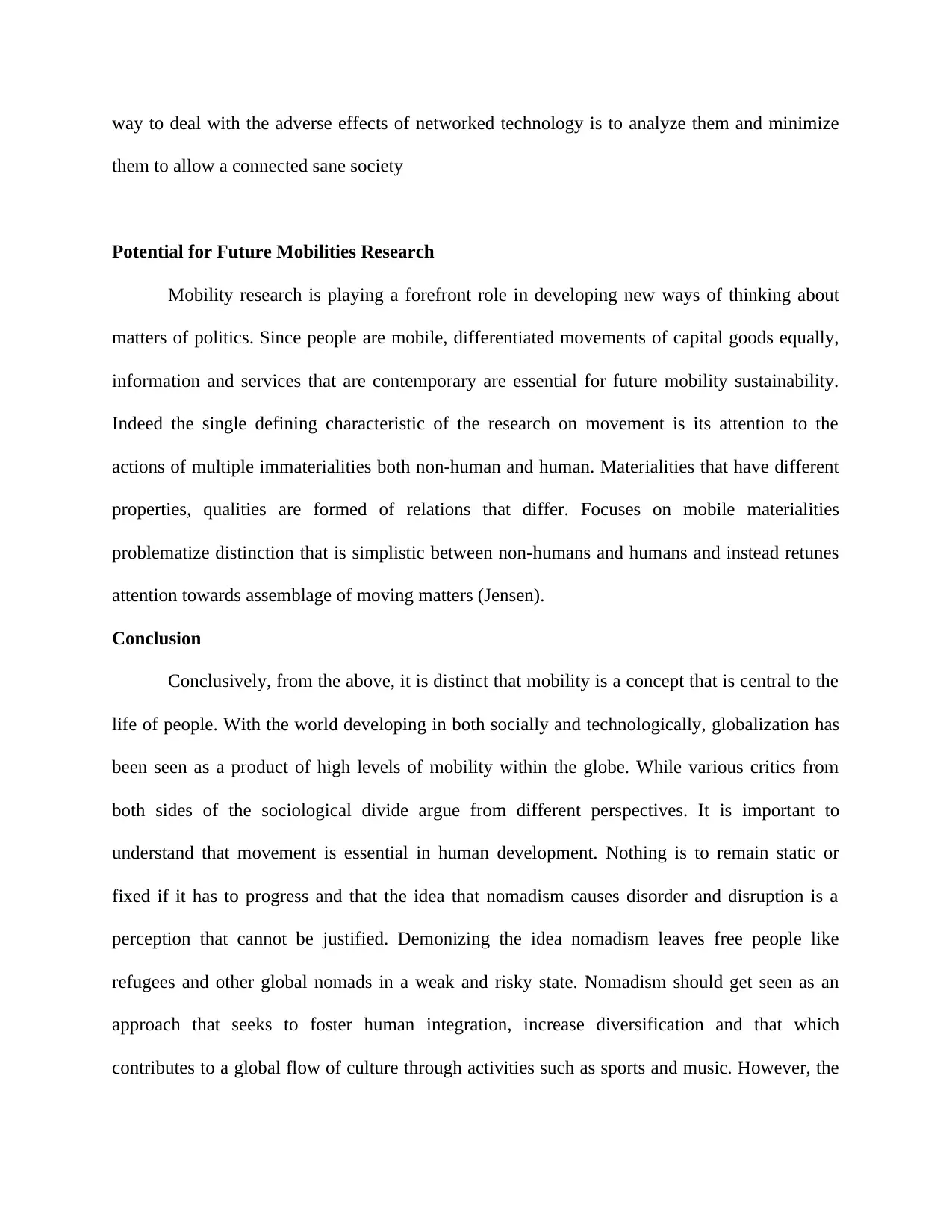
way to deal with the adverse effects of networked technology is to analyze them and minimize
them to allow a connected sane society
Potential for Future Mobilities Research
Mobility research is playing a forefront role in developing new ways of thinking about
matters of politics. Since people are mobile, differentiated movements of capital goods equally,
information and services that are contemporary are essential for future mobility sustainability.
Indeed the single defining characteristic of the research on movement is its attention to the
actions of multiple immaterialities both non-human and human. Materialities that have different
properties, qualities are formed of relations that differ. Focuses on mobile materialities
problematize distinction that is simplistic between non-humans and humans and instead retunes
attention towards assemblage of moving matters (Jensen).
Conclusion
Conclusively, from the above, it is distinct that mobility is a concept that is central to the
life of people. With the world developing in both socially and technologically, globalization has
been seen as a product of high levels of mobility within the globe. While various critics from
both sides of the sociological divide argue from different perspectives. It is important to
understand that movement is essential in human development. Nothing is to remain static or
fixed if it has to progress and that the idea that nomadism causes disorder and disruption is a
perception that cannot be justified. Demonizing the idea nomadism leaves free people like
refugees and other global nomads in a weak and risky state. Nomadism should get seen as an
approach that seeks to foster human integration, increase diversification and that which
contributes to a global flow of culture through activities such as sports and music. However, the
them to allow a connected sane society
Potential for Future Mobilities Research
Mobility research is playing a forefront role in developing new ways of thinking about
matters of politics. Since people are mobile, differentiated movements of capital goods equally,
information and services that are contemporary are essential for future mobility sustainability.
Indeed the single defining characteristic of the research on movement is its attention to the
actions of multiple immaterialities both non-human and human. Materialities that have different
properties, qualities are formed of relations that differ. Focuses on mobile materialities
problematize distinction that is simplistic between non-humans and humans and instead retunes
attention towards assemblage of moving matters (Jensen).
Conclusion
Conclusively, from the above, it is distinct that mobility is a concept that is central to the
life of people. With the world developing in both socially and technologically, globalization has
been seen as a product of high levels of mobility within the globe. While various critics from
both sides of the sociological divide argue from different perspectives. It is important to
understand that movement is essential in human development. Nothing is to remain static or
fixed if it has to progress and that the idea that nomadism causes disorder and disruption is a
perception that cannot be justified. Demonizing the idea nomadism leaves free people like
refugees and other global nomads in a weak and risky state. Nomadism should get seen as an
approach that seeks to foster human integration, increase diversification and that which
contributes to a global flow of culture through activities such as sports and music. However, the
Paraphrase This Document
Need a fresh take? Get an instant paraphrase of this document with our AI Paraphraser
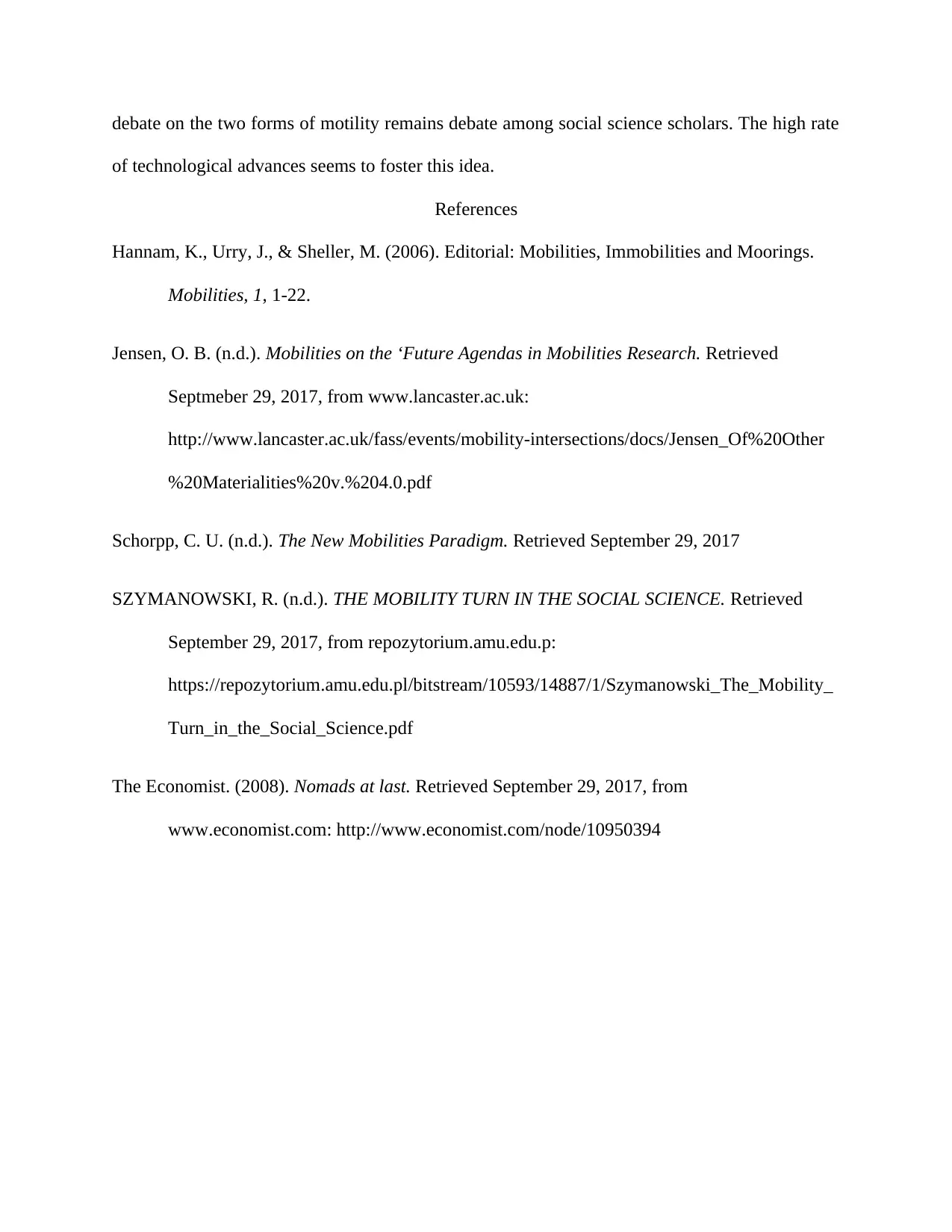
debate on the two forms of motility remains debate among social science scholars. The high rate
of technological advances seems to foster this idea.
References
Hannam, K., Urry, J., & Sheller, M. (2006). Editorial: Mobilities, Immobilities and Moorings.
Mobilities, 1, 1-22.
Jensen, O. B. (n.d.). Mobilities on the ‘Future Agendas in Mobilities Research. Retrieved
Septmeber 29, 2017, from www.lancaster.ac.uk:
http://www.lancaster.ac.uk/fass/events/mobility-intersections/docs/Jensen_Of%20Other
%20Materialities%20v.%204.0.pdf
Schorpp, C. U. (n.d.). The New Mobilities Paradigm. Retrieved September 29, 2017
SZYMANOWSKI, R. (n.d.). THE MOBILITY TURN IN THE SOCIAL SCIENCE. Retrieved
September 29, 2017, from repozytorium.amu.edu.p:
https://repozytorium.amu.edu.pl/bitstream/10593/14887/1/Szymanowski_The_Mobility_
Turn_in_the_Social_Science.pdf
The Economist. (2008). Nomads at last. Retrieved September 29, 2017, from
www.economist.com: http://www.economist.com/node/10950394
of technological advances seems to foster this idea.
References
Hannam, K., Urry, J., & Sheller, M. (2006). Editorial: Mobilities, Immobilities and Moorings.
Mobilities, 1, 1-22.
Jensen, O. B. (n.d.). Mobilities on the ‘Future Agendas in Mobilities Research. Retrieved
Septmeber 29, 2017, from www.lancaster.ac.uk:
http://www.lancaster.ac.uk/fass/events/mobility-intersections/docs/Jensen_Of%20Other
%20Materialities%20v.%204.0.pdf
Schorpp, C. U. (n.d.). The New Mobilities Paradigm. Retrieved September 29, 2017
SZYMANOWSKI, R. (n.d.). THE MOBILITY TURN IN THE SOCIAL SCIENCE. Retrieved
September 29, 2017, from repozytorium.amu.edu.p:
https://repozytorium.amu.edu.pl/bitstream/10593/14887/1/Szymanowski_The_Mobility_
Turn_in_the_Social_Science.pdf
The Economist. (2008). Nomads at last. Retrieved September 29, 2017, from
www.economist.com: http://www.economist.com/node/10950394
1 out of 8
Your All-in-One AI-Powered Toolkit for Academic Success.
+13062052269
info@desklib.com
Available 24*7 on WhatsApp / Email
![[object Object]](/_next/static/media/star-bottom.7253800d.svg)
Unlock your academic potential
Copyright © 2020–2025 A2Z Services. All Rights Reserved. Developed and managed by ZUCOL.